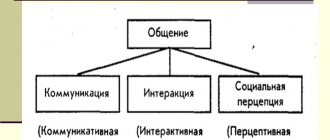Communication style significantly determines a person’s behavior when interacting with other people.
The specific choice of communication style is determined by many factors: a person’s personal characteristics, his worldview and position in society, the characteristics of this society, and much more. How many communication styles are there? This question is difficult to answer.
However, if we proceed from the fact that a communication style is simply a person’s greater readiness for a particular situation, then we can talk about three main styles. They can conditionally be called ritual, manipulative and humanistic.
Classification
Communication styles in psychology are most clearly manifested in the business sphere, in boss-subordinate interactions or between equal partners. Most researchers have based their classifications on research in this area.
The second most important area of study of communication styles is pedagogy. A clear manifestation of types occurs in the interaction between teacher and student.
According to K. Levin
The first classification of communication styles was created in 1939 by a group of scientists led by K. Lewin. The classification is the simplest, but due to its clarity, remains the most popular to this day.
The study of the issue was carried out in the field of leadership using an experimental method. Different groups of students completed identical tasks under the guidance of mentors who represented different styles of leadership communication.
| Style | Description | pros | Minuses |
| Authoritarian (directive) | The leader’s communication with the team comes down to sending instructions (directives), which are not subject to discussion and are mandatory. The subject of interaction makes sole decisions on issues of personal actions and the actions of other subjects. The opinions and convenience of other subordinates are not important. The personal initiative of each team member is not encouraged. Leadership is carried out using methods of dictatorship and hyper-custody. | Can have a positive effect in cases where the leader is the most competent person and quick decisions are needed when urgent action is needed, without discussing the opinions of other team members. | Rigid management, which does not take into account the opinions of experienced employees, leads to abuse of power, the development of conflict situations, and staff turnover, as a result of which knowledgeable specialists are lost. |
| Liberal (permissive) | The role of the leader is reduced to a minimum, as is his responsibility for the results of his activities. There is no control over the process or occurs selectively, unsystematically. In communication, indifference to the problems of the team and individuals is manifested. | It can be useful in a society where all team members have equal competence, qualifications and perform strictly defined isolated actions. | Irrational use of resources and time. Lack of control leads to a lack of motivation and loss of interest in the results of work. Hidden conflicts within the team. |
| Democratic | The style assumes the active participation of the leader in the activities of the group, while taking into account the point of view of each employee. The leader provides general guidance and control, provides assistance, encouraging the active work of everyone. Important decisions are made jointly. Management methods - requests, explanations, recommendations. | This leadership style implies high competence and impartiality of the leader. It is not always appropriate to demonstrate democracy in critical situations when urgent decision-making and implementation of actions according to strict instructions are required. | The manager's democratic communication style is recognized as the most effective. In this case, everyone’s potential is maximized, but at the same time discipline is maintained and high motivation is present. |
According to S. Bratchenko
The modern interpretation of interpersonal communication styles, developed under the leadership of Sergei Bratchenko at the end of the twentieth century, is also popular in psychology.
The styles identified in this classification, according to scientists, are found equally in various situations of interpersonal communication.
- The authoritarian style involves a focus on leadership and suppression of the interlocutor’s personality. This style of communication defines aggressive communication, egoism, and the requirement of complete agreement with one’s position. The interlocutor’s opinion is suppressed and not taken into account.
- The dialogical style of communication is based on trust and mutual understanding. The dialogue is conducted with respect for the opinions of all parties, which are focused on cooperation and mutual self-expression.
- The algerocentric style manifests itself when an individual’s communication is aimed at the needs of the interlocutor. Self-interests are ignored and voluntarily suppressed. The primary task is the development of the interlocutor, sometimes to the detriment of one’s own well-being.
- The manipulative style is focused on dialogue with the aim of using information for personal interests. Communication interlocutors act as means to achieve a specific individual goal. There is some cunning in communication: you should understand the interlocutor as best as possible in order to obtain information, while deeply hiding your intentions.
- A comfortable style implies a willingness to accept the position of the interlocutor, without wanting to express one’s point of view. An interlocutor who is characterized by this style of communication does not strive to conduct a constructive dialogue, to reveal his position, as well as to understand the position of his partner. Complete agreement with the point of view of the interlocutor, without delving into the essence.
- Indifferent - a style that manifests itself in a complete reluctance to communicate. The goal is to close the problem, no matter in what way, and walk away from cooperation.
According to L. Petrovskaya
Leading Russian social psychologist Larisa Petrovskaya (1937 – 2006) based her classification of styles on the factor of the situation itself in which communication arose.
Based on this, she identifies 3 main communication styles:
- The ritual style aims to satisfy the need to belong to a social group, a certain sphere of relations. The purpose of communication between partners is to maintain connections with the surrounding society. A partner in such a situation is a necessary attribute of achieving the goal. Ritual communication implies knowledge of the rules of a given society. Personal interests and characteristics are not taken into account in this case. The manifestation of a ritual style is most often characteristic of a society of people who have known each other for a long time or for organizations with a stable team.
- The manipulative type of communication is manifested in the use of partners to perform one’s own tasks. This is not always a negative thing. By presenting their best qualities and advantages to each other, partners solve many problems and each win in their own matter. To use this method of communication, you need to have skills in manipulating people.
- The humanistic style is manifested in equal interaction, when partners do not aim to promote purely personal interests, but care about the comfort and self-realization of the partner. In the process of communication, the parties support each other, respect the opinions of others, and do not try to manipulate or re-educate. The main conversational genre in this case is dialogue, during which all points of view are expressed. The decision is made on the basis of agreements and compromises, by the opinion of the majority. The humanistic style is the most democratic, but often in solving important production problems it is effectively used as an auxiliary option.
In social psychology
Each person has his own special style of communication, not only in the business sphere. In social psychology, there are several styles that classify a person’s behavior in communicating with others.
- A creative-productive (joint creativity) style allows all participants in joint activities to demonstrate their best qualities. In this case, partners strive for a common goal and find a single correct solution through joint efforts. Professional competence and personal ethical qualities are most clearly demonstrated.
- A friendly style involves communication based on respect and friendly disposition of partners towards each other. Sincere interest in the partner's personality and openness to him are a prerequisite for success in business.
- The distance style is widespread in the field of pedagogical communication, in the “teacher-student” connection. Distance determines the leading role of one of the participants and emphasizes the partner’s differences in age, social status, professional competence and other qualities. When maintaining this style of communication, it is important to choose the right area of its application in order to maintain a reasonable distance, but not go to the stage of complete detachment and dictatorship.
- The suppressive (mentoring) style is an aggressive manifestation of the distance style. In this case, one of the partners takes on the role of an all-knowing mentor-mentor, so that the opinion will be the main and unquestioning one. A constant patronizing tone in dialogue can lead to a breakdown in trusting relationships or a complete cessation of contacts.
- The flirting style can be seen as the unproductive extreme of the friendly style. The manifestation of the appearance of friendship is in this case insincere in nature, the goal is to gain artificial authority from the desired person. Often found in relationships between adults and children or in communication with subordinates of an inexperienced manager. Flirting can play a positive role in the beginning of a relationship between two people of the opposite sex.
Depending on the orientation of the individual
Communication styles in psychology are also classified depending on the orientation of the person:
- Executive – focus on carrying out assignments in accordance with the chain of command and accepted interpersonal contacts.
- Initiative – focus on one’s interests and business.
- The aggressive style is characteristic of individuals who strive to achieve success by controlling the actions of others.
- The aloof style is manifested by independent behavior and attempts to maintain a certain distance.
- The altruistic style is focused on helping others, to the detriment of one's own interests.
- Missionary – careful influence on other people.
- The attentive style is manifested by such signs as a sincere interest in the affairs of others and the ability to express grace.
- The transformational style is sometimes used by business people when, by appealing to high ideals, they try to direct their interlocutor to change their previous goals.
According to the criterion of adequacy of methods and means of communication
Classification of communication styles is also carried out according to the level of adequacy of methods and means of communication.
Based on these factors, 3 styles are distinguished:
- Flexible is a style characterized by a high degree of adequacy in the choice of communication means and behavior. Understanding the emotional state of the partner and the purpose of communication.
- Regular - a style in which there is no assessment of communication capabilities and analysis of communication strategy. The emotional state of the interlocutor is not subject to assessment, the subtext of the message is not considered.
- The transitional style combines the characteristics of flexible and rigid styles, depending on the circumstances.
One should not conclude that manipulation is a negative phenomenon.
A huge number of professional tasks involve manipulative communication. In fact, any training (the subject needs to be given new knowledge about the world), persuasion, control always includes manipulative communication. That is why the effectiveness of these processes largely depends on the degree of mastery of the laws and techniques of manipulative communication.
Manipulative communication is an extremely common type of communication that occurs mainly where there is joint activity. It is important to remember one significant point - a person’s attitude towards manipulative communication and the reverse impact of the manipulative style.
Imagine that you are sitting in the office of a mid-level executive who receives frequent phone calls. The style of conversation changes all the time. If the opponent’s status is higher, one tone, if lower, another tone. This is a typical example of manipulative communication, and everyone will explain to themselves that “this is how it should be, otherwise you won’t do anything.” However, this is unpleasant for many.
And finally, there is a reverse influence of manipulative communication on the person who uses it. There is a manipulative deformation of personality in cases where, due to the frequent professional use of manipulative communication, good technology for its use and, accordingly, constant success in this field, a person begins to consider manipulative communication the only correct one. In this case, all human communication comes down to manipulation (both when it is necessary and when it is completely unjustified).
Humanistic communication. This is the most personal communication, allowing you to satisfy such human needs as the need for understanding, sympathy, and empathy. Neither ritual nor manipulative communication can fully satisfy this vital need. The goals of humanistic communication are not fixed or planned initially. Its important feature is that the expected result of communication is not the maintenance of social connections, as in ritual communication, or a change in the partner’s point of view, as in manipulative communication, but a joint change in the ideas of both partners, determined by the depth of communication.
Definition
Communication style in psychology does not have a clear unambiguous definition. Representatives of various psychological schools interpret the concept in their own way.
So, the style of communication as interpreted by theorists is:
- A constant way of building relationships for a particular person in various areas, which is an individual trait (Levin).
- The form in which the exchange of acts of communication occurs (E. Subbotsky).
- The model of communication between people that an individual prefers (S. Bratchenko).
Modern psychological schools, summarizing the experience of previous and the latest research, define the concept of communication style as an individually constant form of a person’s communicative behavior depending on the conditions of interaction.
Diagnostics
Anyone can adjust their communication style in the right direction in order to establish harmonious relationships in a family or team. The beginning of such work is psychological testing, which helps to establish the individual’s real attitude towards others, his innate abilities and inclinations. There are many tests to determine personal communication style.
The most popular of them are:
- Test of interpersonal relationships by American psychologist Timothy Leary, created in 1950, adapted for the Russian-speaking environment by Lyudmila Sobchik. The purpose of the test is to determine the personal image of oneself and the predominance of the type of communication. The test consists of 2 parts and contains 128 statements about a person’s character. How he sees himself ideally and in the present period. The test can be used for personal assessment and for assessing a person “from the outside.” It is also possible to determine the degree of objectivity of self-assessment.
- The Persistence-Acquiescence Test is one of a series of interpersonal tests created by Hans Eysenck and Glen Wilson. The 210 questions have "yes" and "no" answer options. Using the test, the basic characteristics of an individual’s communication are determined: aggressiveness or flexibility, the ability to manipulate, the desire for leadership or subordination.
- “Diagnostics of communicative aggression” is a technique developed by Russian psychologist Viktor Boyko. The test allows you to determine the degree of aggressiveness in a relationship and the ability to switch. The “Aggression Index” is based on 11 parameters.
- “Diagnostics of the type of communicative attitude” was created under the leadership of Viktor Boyko to determine the presence and magnitude of the manifestation of negative attitudes in communication. The test consists of 25 questions that have “yes” and “no” answer options.
- The Interpersonal Relations Questionnaire by the American psychologist William Schutz is designed to determine the communicative characteristics of a person.
- The SMIL test was developed according to the basic method of L. Sobchik creates a complete psychological portrait of a person, including his communication styles. To get complete information about yourself you need to spend time and answer 567 questions. But there is also a shortened version of 65 questions.
Nowadays, you can take many tests and get results within a few minutes on the Internet online for free. The disadvantage of such studies is that a person who is not a specialist in the field of psychology cannot always objectively evaluate the test results. For serious research, it is better to contact a professional consultation center.
Psychological centers often conduct diagnostics of styles and other components of communication in the business sphere. Such services can be ordered by companies to assess the level of employees, or by individuals. The cost of services depends on the choice of specialist and the range of studies. The approximate initial cost of one test with comments from a psychologist is about 1,500 rubles.










